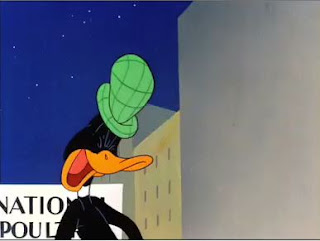
Here's some fun animation from Chuck Jones' "You Were Never Duckier" 1948, Chuck's funniest year.
There are accents in speech that you can hear. People (and ducks) punctuate those verbal accents with visual cues. That's what actors try to mimic.
TOOL 2) USING THE HEAD MOTION AS VISUAL PUNCTUATION
THE GENERAL IDEA:
pose

http://www.cartoonthrills.org/blog/Jones/47Duckier/DaffyHeadacting.mov
VARY THE STRENGTH OF YOUR ACCENTS:
GET A BIGGER ACCENT BY USING A STRONGER ANTIC
KEY
GET A BIGGER ACCENT BY USING A STRONGER ANTIC
KEY

SPINNING ANTIC FOR BIG ACCENT




You can also use gestures to help punctuate the dialogue. This bit has much stronger emphasis in dialogue, so uses more visual accents and signals and with great variety. It doesn't seem typical of Jones, because it's very exaggerated. It looks a lot like some animation in his hilarious "Pest In The House" which appears very influenced by Clampett. Jones' cartoons calmed down quickly after these cartoons.
http://www.cartoonthrills.org/blog/Jones/47Duckier/DaffyGestureActingsmall.mov



Basic tools of visual acting:
1) Expressions
http://johnkstuff.blogspot.com/2006/03/specific-acting-in-looney-tunes-duck.html
2) Head Motions (this post)
3) Arm and hand gestures
http://mayersononanimation.blogspot.com/2007/06/six-authors-in-search-of-character-part_13.html
4) Body poses
http://johnkstuff.blogspot.com/2007/04/foghorn-leghorn-mckimson-henerys-dad.html
Most animators shy away from strong expressions and instead rely on the other 3 tools. You can use any and all of them in different proportions to create variety and emphasis.
A good voice track should inspire the animator to use which visual accompaniments most fit the track. The best animators customize their acting to fit the track. Most use formula.







